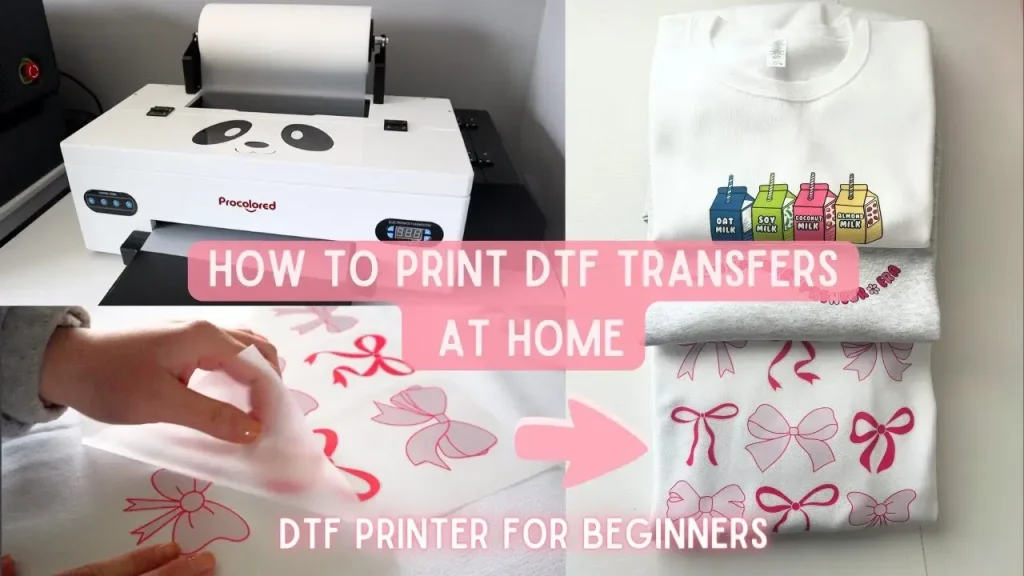Looking to enhance your fabric printing skills? DIY DTF transfers might be just what you need! This innovative method, which stands for Direct-to-Film, allows you to easily create stunning, professional-quality designs right at home. With DTF printing, vibrant colors and intricate details come to life, making it an appealing option for both beginners and experienced crafters. In this guide, we’ll explore everything from how to DTF transfers and the essential DTF transfer materials to effective techniques for printing on fabric, ensuring your DIY transfer designs hit the mark!
In the realm of personalized fabric decoration, the art of creating custom transfer prints is rapidly gaining popularity. Such techniques enable you to design unique patterns and images, resulting in eye-catching apparel that showcases your creativity. Using methodologies like DTF (Direct-to-Film) printing, enthusiasts can efficiently transfer their designs onto various fabrics, revolutionizing the way we think about DIY clothing projects. This guide will navigate you through the process of crafting these stylish transfer designs, ensuring you grasp all the nuances and materials needed to succeed in the exciting world of custom apparel creation.
The Basics of DTF Printing Explained
Direct-to-Film (DTF) printing is a transformative technique in the world of custom garment decoration. It stands out due to its ability to deliver intricate designs with vibrant colors directly onto fabric, unlike traditional methods that often require multiple processes. This printing technology utilizes a special film to carry the artwork, ensuring that even the most delicate details are preserved seamlessly. The freedom DTF provides in terms of design complexity makes it a perfect choice for hobbyists and professionals aiming to enhance their apparel with unique visuals.
One of the greatest advantages of DTF printing lies in its eco-friendliness and efficiency. There is no need for pre-treatment of fabrics, which not only simplifies the process but also reduces the consumption of chemicals typically used in other printing methods. By employing water-based inks and reducing waste during setup and production, DTF printing aligns with sustainable practices. This feature resonates well with consumers seeking environmentally responsible options while allowing creators to fully express their artistic visions.
Essential Supplies for DIY DTF Transfers
Creating stunning DIY DTF transfers requires specific materials to ensure optimal results. At the heart of the process is the DTF transfer film, which acts as a medium for transferring your designs onto fabric. It is crucial to select high-quality films that are compatible with your printer, as this directly influences the vibrancy and durability of the final print. Additionally, using the correct adhesive powder is vital; it ensures that the design firmly adheres to the fabric after the heat pressing process, creating a long-lasting finish.
Investing in a reliable heat press should also be part of your essential supplies. A dependable machine guarantees even heat distribution and pressure, which are critical for successful transfers. Variations in temperature or inconsistency in pressure can lead to peeling or fading designs. Therefore, understanding the specific requirements of your materials and ensuring you’re equipped with the right tools will significantly impact the overall quality of your DTF prints, making it a worthwhile investment for any DIY enthusiast.
Step-by-Step Guide to Creating DTF Transfers
Ready to dive into the DIY DTF transfer process? The first step is creating your design, which you can do using various graphic design software applications. Select one that you’re comfortable with and ensure your artwork’s resolution is high; this will prevent pixelation in the final print. Once your design is ready, it’s essential to save it in the correct file format so it maintains its integrity throughout the printing process.
After printing your artwork onto the DTF transfer film, the next crucial step is adding the adhesive powder while the ink is still wet. This is where many beginners often get it wrong. It’s paramount to apply the powder evenly across the entire design to avoid any spots that might not stick during the heat press application. Once completed, you can proceed with the heat transfer to your fabric, ensuring you follow the recommended settings for temperature and time to achieve the best results.
Benefits of Using DTF Transfers in Custom Apparel
The popularity of DTF transfers in custom apparel is primarily driven by their high-quality results. This printing technique allows for sharp, eye-catching designs that can withstand multiple washes without fading or peeling. Users appreciate that DTF transfers can be applied to a wide range of fabric types, including cotton, polyester, and blends, making them versatile for various clothing items—from t-shirts to hoodies.
Another significant advantage of DTF transfers is the user-friendly nature of the process, which is particularly beneficial for beginners. Unlike traditional printing methods that require extensive experience and skill, DIY DTF transfers enable enthusiasts to produce professional-quality designs quickly and effectively. With the proper materials and dedication to learning the process, anyone can achieve stunning apparel designs without the need for highly specialized training.
Common Challenges with DTF Transfers and How to Overcome Them
While DIY DTF transfers come with many benefits, several challenges can arise, particularly for those new to the technique. One common hurdle is the initial investment required for quality equipment and materials. A precise printer, heat press, and suitable transfer films can be pricey, leading potential DIYers to hesitate before committing. However, understanding the long-term savings from producing custom designs can justify the upfront costs.
Another challenge relates to mastering the application of adhesive powder and achieving effective heat transfer. Many first-time users may find inconsistencies in their results, such as peeling or incomplete transfers. To overcome this, practice is essential. Taking the time to experiment with different fabrics and adjusting heat settings allows users to refine their technique. Additionally, utilizing online resources and tutorials can provide valuable insights to help troubleshoot common issues and elevate their results.
Exploring Resources for DIY DTF Transfer Success
To enhance your skills in DIY DTF transfers, numerous resources are available to guide you. For those just starting, visiting blogs like Printavo can be incredibly beneficial, as they provide extensive information on equipment, techniques, and troubleshooting tips. These resources often break down complex aspects of the process into digestible steps, making it easier to comprehend and apply.
In addition to written guides, video tutorials on platforms like YouTube can offer visual learners a chance to watch skilled printers demonstrate essential techniques in real-time. Online forums and communities, such as Reddit’s r/screenprinting, also serve as valuable platforms for exchanging ideas, solutions, and inspiration among fellow DTF enthusiasts. Engaging with these communities can help you stay updated on best practices and innovative designs while boosting your confidence in your DIY DTF printing journey.
Frequently Asked Questions
What are DIY DTF transfers, and how do they work?
DIY DTF transfers, or Direct-to-Film transfers, involve printing designs onto a special film that is then transferred onto fabric using heat and pressure. The process uses a printer, DTF film, adhesive powder, and a heat press to create vibrant, professional-quality designs that adhere well to various materials.
What materials do I need for DTF transfer projects?
To start your DIY DTF transfers, you will need a suitable printer (like a DTF printer or a modified inkjet printer), DTF transfer film, adhesive powder, and a heat press. These key DTF transfer materials are essential for ensuring successful and vibrant fabric designs.
How do I create designs for DIY DTF transfers?
Creating designs for DIY DTF transfers involves using graphic design software, such as Adobe Illustrator or free tools like Inkscape. Ensure your design is high resolution, then print it onto DTF film. Following this, sprinkle adhesive powder on the wet ink before transferring it onto fabric using heat.
What is the process for applying DTF transfers to fabric?
The DTF transfer process includes printing your design on DTF film, applying adhesive powder, curing the adhesive, and then using a heat press to transfer the design onto your fabric. Proper heat and pressure settings are crucial for achieving the best results.
Can I use DTF transfers on any fabric?
Yes, DTF transfers are versatile and can be used on a variety of fabrics, including cotton, polyester, and blended materials. This makes them an excellent choice for custom apparel and fabric projects.
What are the benefits of using DIY DTF transfers compared to other printing methods?
DIY DTF transfers offer high-quality, vibrant results without the need for fabric pretreatment, making them simpler and more efficient than traditional screen printing. They also allow for intricate designs and are suitable for various fabric types, appealing to both hobbyists and small businesses.
| Key Components | Process Steps | Advantages | Challenges |
|---|---|---|---|
| Printer (DTF or modified inkjet) | Design Creation using software | High-Quality Results | Initial Equipment Costs |
| DTF Transfer Film | Printing the Design | Versatile Applications | Learning Curve |
| Adhesive Powder | Adding Adhesive Powder | User-Friendly Process | |
| Heat Press | Heat Transfer to Fabric |
Summary
DIY DTF Transfers offer an innovative way to create stunning and professional-quality designs right from your own home. This technique combines modern printing technology with artistic creativity, enabling individuals to transfer intricate and vibrant designs onto a variety of fabrics. Unlike traditional methods, DTF transfers simplify the process by eliminating the need for fabric pretreatment, making it an appealing option for both hobbyists and small businesses. By investing in the right equipment and understanding the application process, anyone can produce high-quality custom apparel that stands out. The satisfaction of bringing personal designs to life will encourage continuous exploration and mastery in the art of DIY DTF Transfers.



